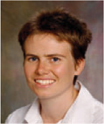The Measurement and Meaning of Intrinsic Radical Stability: Are Chemical Questions just Problems in Applied Mathematics?
Michelle L. Coote A C and Adam B. Dickerson B CA Australian Research Council, Centre of Excellence for Free Radical Chemistry and Biotechnology, Research School of Chemistry, Australian National University, Canberra ACT 0200, Australia.
B School of Professional Communication, University of Canberra, Canberra ACT 2601, Australia.
C Corresponding authors. Email: mcoote@rsc.anu.edu.au; adam.dickerson@canberra.edu.au

Michelle Coote is a fellow of the Research School of Chemistry, Australian National University, and a member of the Australian Research Council Centre of Excellence for Free Radical Chemistry and Biotechnology. She is a graduate of the University of New South Wales, where she completed a B.Sc.(Hons) in industrial chemistry, followed by a Ph.D. in polymer chemistry (2000). She has published extensively in the fields of free-radical polymerization kinetics, radical chemistry and computational quantum chemistry, and is a recipient of the RACI Cornforth medal (2000), the IUPAC prize for young scientists (2001), the ANU Rita Cornforth Fellowship (2003) and the RACI Rennie Medal (2006). |

Adam Dickerson is a lecturer in the School of Professional Communication, University of Canberra. He is a graduate of the University of New South Wales, where he completed a B.A.(Hons), followed by a Ph.D. in philosophy (2001). His research interests include philosophy of science, philosophy of language, epistemology and the history of philosophy. He is the author of Kant on Representation and Objectivity (Cambridge UP, 2004), among other works. |
Australian Journal of Chemistry 61(3) 163-167 https://doi.org/10.1071/CH07339
Submitted: 24 September 2007 Accepted: 24 January 2007 Published: 26 March 2008
Acknowledgement
Financial support (to M.L.C.) from the Australian Research Council under their Centres of Excellence program is gratefully acknowledged. We are also grateful to Professor Peter Gill for his thoughtful criticism of an earlier draft of the present paper.
[1]
[2]
[3]
[4]
D. J. Henry,
C. J. Parkinson,
P. M. Mayer,
L. Radom,
J. Phys. Chem. A 2001, 105, 6750.
|
CAS |
|
CAS |
|
CAS |
|
CAS |
|
CAS |
| Crossref | GoogleScholarGoogle Scholar |
CAS |
|
CAS |
|
CAS |
|
CAS |
|
CAS |



